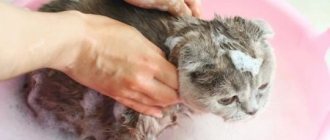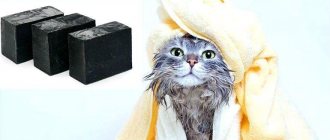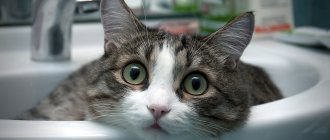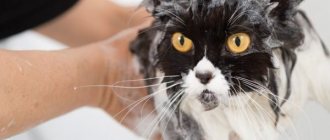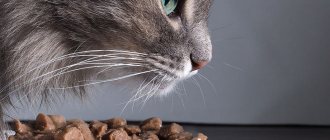Can I wash my cat with regular shampoo? It is not advisable to do this. After all, the skin of a cat and a person is different. It is no coincidence that special detergents have been created for pets. These pet shampoos are made taking into account all the characteristics of animal fur and skin. Constant use of human hygiene products can lead to a deterioration in the appearance of your furry pet. But there are times when an animal needs to be washed urgently, and a special detergent is not at hand. Can I wash my cat with regular shampoo or soap? This can only be done in exceptional cases and very rarely. However, not just any shampoo or soap can be used for people.
Mr. Cat explains: is it possible to wash a cat with human shampoo?
In order to wash the cat painlessly for everyone, this should be approached responsibly, training the pet in a timely manner and preparing all the necessary means. Sometimes you don’t have “cat” shampoo on hand, and then the question arises: is it possible to wash a cat with human shampoo?
Veterinarians and breeders are categorically against the use of “human” shampoos for pet care.
They give the following arguments:
- The hair structure of cats and humans is too different. Cats have fewer glands that secrete sweat and oil. Therefore, human shampoo contains a much higher content of surfactants, which in such quantities simply dry out the skin and fur of pets.
- The epidermis (i.e. the upper part of the skin) of a pet is much thinner and more sensitive than that of a person.
- The value of the acidity index also differs. A cat's pH is 4-6, a person's is from 3 to 4.5.
- Cats have two types of hair: guard hair and down hair. There is an air cushion between them, so a cat’s coat is a whole system that needs very delicate influence (we write more about the structure of hair in cats at the end of the article, so read to the end, there is a lot of useful information there).
- The presence in human shampoos of aromatic and often strong-smelling substances, microscopic additives for shine or tint, harmful to cats.
- Many “human” detergent compositions contain extracts from herbs and other natural components that can cause allergic reactions in cats.
Of course, if you wash your cat with “human” shampoo once, and with all the precautions, then the harm will be minimal. The main thing is not to do this systematically; it is still better to purchase a specialized cleaning composition for your pet. After all, manufacturers develop pet shampoos taking into account the characteristics of the coat, and products for humans, when used regularly, can cause irreparable harm to the appearance and health of a cat. The wool will fade, lose its natural shine, become dull and brittle, and will mat and form tangles.
Alternative for swimming
When there are no washing products, but you need to buy a cat, you can use any hair product that does not contain fragrances or dyes and contains a low pH level.
Instead of bathing the animal, you can wipe it with a damp cloth to remove dirt.
Washing a cat with human shampoo is allowed, but only in exceptional cases. This must be done while adhering to the recommendations for bathing the animal.
Previous
Care How to properly clean a kitten's ears from dirt
Next
Care How to clean a cat's nose: proper procedure, necessary tools
What to do if there is no suitable shampoo
If there is an urgent need to bathe your pet and you don’t have a cat wash product at hand, then preference should be given to the following “human” shampoos:
- For children without fragrances (for example, with the smells of apples or peaches) - they contain the least harmful substances and contain components that allow bathing “without tears.” Some breeders even specifically wash kittens with it if they have allergies.
- Contains birch tar. They are relevant for lichen or skin irritations in your pet.
- Based on goat's milk or kumis without additional fragrances, it moisturizes the hair and skin of cats well.
In any case, in these exceptional cases, you must choose a product without a strong odor, with a low composition of surfactants, and exclude the content of menthol or pepper.
When using such detergent compositions, it is better to dilute them strongly beforehand (up to one tablespoon per liter of liquid), and after soaping the animal, rinse the foam thoroughly (at least three to four times) until the water becomes clear. Then the pet is dried with a towel to reduce the licking time.
Is it possible to wash a kitten with laundry soap?
The most natural soap is considered to be laundry soap. It is valued for its good cleaning ability. But it is wrong to believe that it is suitable for bathing kittens.
Common people believe that they can wash cats with laundry soap. It’s better not to do this, but to choose a less aggressive one, with a low alkali content or a neutral PH level.
If there is no special shampoo and the kitten needs to be washed, a solution of laundry soap will do. It is suitable as an emergency measure. The cat may develop dandruff and itchy skin after a bath. Some cats experience hair loss, and allergic reactions are possible.
Laundry soap 72% from the era of socialism for a pet is a kind of poison. It is important to rinse the wool well so that the pet is not poisoned by soap components.
If you find problems after washing with laundry soap, you should immediately contact a veterinarian. He will tell you how to minimize the effects of alkaline attack on the skin.
Shampoos for cats
If bathing your pet is necessary, you should choose the appropriate shampoo. They come in three types:
- Regular liquid products. They vary in coat type and are sold in any pet store.
- Dry shampoo powders. Created specifically for animals that are too afraid of water or have thick, long, long-drying hair.
- Sprays also offer the opportunity to provide an alternative to water bathing. A special composition is applied to the pet’s fur and rubbed with a dry cloth. This is a fairly expensive method of cleaning a pet and is not yet very widespread, although it is effective.
Today, regular liquid cat shampoos are still popular. They, in turn, are divided into the following groups.
Read about how to properly wash a cat.
Caring shampoos for cats
These products also contain a weak concentration of alkali and are designed to improve the appearance of the coat and hair structure, giving it shine and silkiness, preventing excessive loss and brittleness. Most often, they also contain various vitamin supplements and fatty acids.
There are also specialized vitamin shampoos that are used with oral intake of complexes enriched with micro- and macroelements.
There are special shampoos for excessive oily hair that regulate the functioning of the sebaceous glands. This is ensured by the inclusion of herbal extracts, for example, from tea tree, and antibacterial complexes.
Preventive shampoos for dry hair, on the contrary, moisturize and nourish hairs due to substances similar to sebaceous secretions. The hairs seem to be sealed and become unaffected by ultraviolet radiation.
Modern industry also produces a wide range of detergents for cats of various breeds: Bengals, Britons, Maine Coons, Sphynxes. All of these shampoos have different effects on the coat and skin of pets. For example, “Graceful Sphinx,” in addition to cleansing and nourishing the skin of hairless cats, prevents the occurrence of acne, to which this type of pet is so susceptible. This occurs due to the inclusion of chamomile and other medicinal components.
For Persian cats, a composition is produced that nourishes the follicles and makes it easier to comb long and thick downy hair, preventing the formation of tangles.
Cosmetics for cats
These are not only shampoos, but also balms, tonics, and tint compositions. Most often they are used in the care of show animals to give cats a special shine before competitions.
The progressive part of humanity, however, condemns the use of tinted shampoos, as this is extremely dangerous for the health of pets.
What is the difference between pet shampoos and regular shampoos?
For constant care of cats you need your own means. Less harsh in composition than ordinary shampoos. An important factor of this zoo shampoo is hypoallergenicity. Not only the pet’s comfort during bathing, but also the health of its skin depends on this.
Depending on the purposes, experts divide cat pet shampoos into the following categories:
- Daily. They contain useful additives that provide gentle coat care. They do not cause irritation to the animal, wash away dirt and eliminate unnecessary odors.
- Medical. Use only as directed by a veterinarian for additional disinfection of a kitten or to reduce irritation on its skin.
- Reducing shedding. A cosmetic product for the off-season, when hair loss is intense.
- Exhibition. Contains dyes that enhance the brightness and shine of cat hair.
- Against mats. The composition of such solutions includes components that ensure easy combing and strengthening of hair follicles. This is important for long-haired dogs to prevent the hairs from becoming clumps.
- Antiparasitic or insecticidal (anti-ticks and fleas). They include disinfectants that prevent the animal from becoming infected with skin parasites. Recommended for use on animals that spend a significant amount of time outdoors.
Thus, in order to protect your cat from skin allergies, you can focus on specialized products from well-known brands: Trixie, Goodman, Bioflor, Agrovetzaschita.
Why wash your cat
Cats lick themselves very often, completely several times a day, and in between they will definitely run their tongue over their paws, tail or sides. However, in some situations, bathing your pet is inevitable:
- Before a competition, show or exhibition. In this case, the animal owner, as a rule, has all the necessary specialized hair care products.
- In case of heavy pollution, for example, after a long walk in the rain.
- If substances come into contact with the fur that may be hazardous to the health of the pet.
- With heavy shedding. This is especially true for representatives of long-haired and some semi-long-haired breeds. These pets often suffer during such periods from excessive ingestion of hairballs.
- For medicinal purposes, in particular, when removing external parasites.
However, it must be remembered that excessive bathing can lead to disruption of the protective lubricant and, as a result, to loss of shine and health of the coat. Three to four times a year is the optimal number of procedures.
If the cat often walks, especially at the dacha in the summer, then you can simply wipe it periodically with a damp cloth, and wash only the paw pads every day.
Similar to the need for bathing, there are situations when this procedure is unacceptable:
- If the animal has recently undergone surgery. Washing should be delayed as long as possible, even after sutures and bandages are removed.
- The advanced age of the pet also imposes a ban on bathing. For an old cat, this is too much stress and the risk of getting sick from hypothermia.
- You should also not bathe a pregnant or lactating cat. She doesn’t need foreign odors, additional stress or hypothermia.
- You should postpone the procedure even in the cold season, especially if the house is not too warm or there are drafts.
Why do you need to bathe your pets?
Hygiene procedures for such pets are always associated with stress. At the same time, not only the animal itself, but also its owner. Therefore, in order to bathe a kitten there must be a good reason for this. Among the main factors influencing the need to wash a cat are :
- preparing purebred pets for exhibitions or similar events;
- destruction of fleas or other parasites on the animal’s fur;
- the presence of a huge amount of dirt (especially light-colored pets);
- during the period when the animal sheds and hair falls out in large quantities;
In such cases, there is a special need to wash the kitten so that your pet is a clean and fluffy bundle.
Regular shampoos
How to properly bathe a kitten
In order to gently bathe a small kitten, you should use a specialized shampoo, using baby product only as a last resort.
When bathing your baby, you need to be especially careful not to overcool the kitten, not to pour water into his ears and rub him thoroughly after washing, not to scare him or cause stress.
In the case of using specialized medicated shampoos, they are used strictly as prescribed by the veterinarian and in this case the pet is bathed according to the proposed scheme. As a rule, in this case we are talking about antiallergic drugs, since compositions for removing external parasites up to six months of life are not prescribed due to the high toxic effect of the drugs they contain on the body.
If the kitten is a show class and is planned to be presented at exhibitions and competitions in the future, then it is better to accustom the baby to bathing from an early age. Of course, you shouldn’t do this in the first or even the second month of life, but in three or four months the first procedure can be carried out.
If the kitten has recently moved to a new home, then washing should be delayed for at least two to three weeks to give it time to adapt.
It is also important to postpone bathing for at least a month after vaccinations.
It is important to carefully comb your pet before washing, since if the tangled hairs get wet, tangles are highly likely to form, which can only be removed by cutting.
If your baby begins to get stressed while combing his hair, then you should not immediately take him to the bathroom; it is advisable to give him time to calm down and tune in to a positive mood.
In addition, you can give him treats and play. Under no circumstances should you bathe a kitten immediately after a heavy feeding. You must wait at least two to three hours.
Warm water is filled into a container—a bathtub or basin—preferably at the animal’s body temperature, about 38 °C. To prevent the paws from sliding on the surface of the container, it is advisable to place a towel on the bottom. You can throw toys into the water, this will distract the kitten’s attention during the procedure. By the way, the whole thing should be done in 15 minutes. In this case, it is advisable to prepare the water for rinsing in a separate container in advance. You should douse your baby from a jug or ladle, and not frighten him with the noise of the shower.
The fur should be carefully lathered with the fingers of one hand, carefully holding the pet with the other.
To protect the ears, you can put cotton pads in them, but it is better to wash the face very carefully and last, trying to prevent water from getting into them - this is fraught with otitis media.
It is generally better not to touch the ears. If there are any problems, it is better to contact a veterinarian for cleaning, for example, wax plug. Especially if there is a suspicion of ear mites, this disease is called otodectosis and manifests itself in the formation of characteristic black dots inside the ear.
If after bathing and rubbing the kitten is clearly cold, then it is better to wrap it in a dry towel and carry it in your arms than to use a hairdryer. Firstly, the noise really frightens the baby, and secondly, hot air dries out the hair and makes it brittle.
It is advisable that the first procedure take place positively, in a playful atmosphere. After bathing and completely drying, you need to play with the baby and treat him with a treat and praise him.
Useful video
- When you bathe a cat, do it with someone else - this will make it easier to hold the animal.
- Do not raise your voice to the animal and be extremely gentle.
- After shampooing, rinse the animal's fur thoroughly because it licks itself.
- If bathing is done to drive away fleas, then start with the neck - soap this part of the body, and only then the entire animal.
- The head and ears are washed last, and it is better not to wash them at all. Clean your ears with cotton swabs.
- Remember - the cat should not be overcooled.
Visually see how you can bathe a kitten with regular shampoo.
Today you found out how many times you can wash a kitten with shampoo and whether you can wash a kitten with baby shampoo and regular shampoo.
How to wash if the cat is afraid
A cat's fur protects it well from overheating and excessive cooling, and when wet, the air cushion between the hairs and skin fills with water, and the animal begins to freeze very much. This is why most pets do not like bathing and strive to avoid this procedure with all their might.
Read the article why cats are afraid of water and what to do about it.
In addition, the aroma of detergents is also unpleasant for cats; their delicate sense of smell is simply shocked by these odors. However, specialized cat shampoos take this criterion into account and do not contain fragrances.
If a cat is not accustomed to bathing from an early age, and is also afraid of water, then this procedure can become serious stress for both the pet and the owner.
In order to irritate your cat as little as possible, you should adhere to the following rules:
- It is advisable to invite someone from your household to help.
- Pre-comb the cat's fur and trim its claws.
- Under no circumstances should you shout at your pet; you should only speak in a gentle and soothing tone.
- It is better to place an anti-slip mat at the bottom of the bathing container.
- Remove from the surrounding area everything that could interfere, fall, or additionally frighten the cat, for example, bottles of shampoos and conditioners standing on the edge of the bathtub.
- Prepare several large dry towels.
- Prepare water for rinsing in a separate container; it is better to do it using a jug rather than a shower, so that the extra noise does not further frighten the cat.
- Fill a basin or bathtub with water at the animal’s body temperature so that its surface is slightly higher than the level of the cat’s belly.
- It is worth starting the procedure when the pet is relaxed and calm.
- Going into the bathroom with him, hold him in your arms for a while, talking affectionately.
- Then carefully place in water.
- While your assistant is holding the cat, quickly lather the fur with cat shampoo.
- Then thoroughly but quickly rinse your pet from the ladle at least three times.
- Place the cat on the bathroom floor and rub him well with a towel.
- Then wrap it in a second dry cloth and leave the bathroom.
- Carry the cat in your arms, calming and talking to him affectionately.
- Do not use a hairdryer under any circumstances, this will only frighten your pet even more and discourage him from bathing forever.
- Once the animal is dry enough, lower it to the floor and let it lick itself.
- Play, talk affectionately, offer the cat a treat, praise.
How often can you wash your cat and at what temperature?
Has anyone ever wondered why cats are afraid of water? How justified is their fear? For animals, everything is much simpler; they are not subject to groundless panic. The fear of water in cats is due to the following:
- After swimming, they are at risk of hypothermia or overheating. The air cushion formed between the skin and fur of the cat warms it. After bathing, it disappears, the animal freezes. Also, the coat, naturally moistened with sebum, protects the cat from the scorching rays of the sun. A washed pet loses this protection.
- There is a risk of infection. The cat's sebaceous glands produce a secretion with antibacterial properties. During bathing, it is washed away, leaving the animal defenseless against bacteria, fungi, and other infections.
- Wet wool smells. Cats are by nature nocturnal animals and hunters. They have strong camouflage instincts. Purrs carefully bury feces behind them and carefully lick their fur coat so as not to emit odors. Washed cat fur smells very strongly, and this makes the cat very worried.
Bathing is stressful for a cat.
Therefore, you need to know how often to wash your cat. Veterinarians recommend:
- regularly once every 2-3 months, if the animal is healthy
- more often as needed and after consultation with a specialist
According to the standards established by the World Society of Animal Health:
- Domestic cats need to be bathed three to four times a year.
- If your pet is used to walking outside, then the frequency of bathing should be increased to 6-7 times a year. It is also necessary to clean the furry paws when he comes home from the street.
You shouldn’t get carried away and wash your cat often, especially if there are no detergents designed for this purpose, and you are looking for options on how to wash your cat if there is no special shampoo. Frequently repeated water procedures, and especially with alternative means, leads to a disruption of the pH level (skin fat balance) of the animal, and then the natural protection on the cat’s skin disappears.
When should you wash your pet?
Cats are clean creatures. Veterinarians recommend preventative washing of pets no more than once a month. The reason for unscheduled swimming is:
- entering the house - an animal taken from the street (from a shelter), it is advisable to wash it;
detection of skin parasites;
skin (wool) contamination;
contact with odorous substances – a pet will need a bath if it encounters a skunk.
Fleas and other pests require special products. The product will kill eggs and adult parasites, and will not just wash away some of them, like simple soap. It is advisable to use special veterinary products during the first bath. A cat taken from the street may have parasites and other pathogens on its skin that a professional shampoo will destroy. You must read the instructions.
Many products are not suitable for kittens under 2-3 months of age, elderly individuals with a weakened body, animals suffering from dysfunction of filtering organs (liver, kidneys). Skin disease is a reason to refuse bathing. If lichen is detected, the veterinarian prohibits water procedures for the period of treatment - they contribute to the spread of fungal spores over the surface of the body. Dirt from the affected pet is removed locally, parasites are destroyed with drops on the withers or similar means.
Even with excellent health, the answer to the question of whether it is possible to wash a cat with regular shampoo will remain negative. Human remedies are not suitable for animals due to:
- Composition. Wool and hair require different care. A thick protective layer of fat forms on the skin of cats. Washing it off is fraught with irritation, hair loss, and allergic reactions. Veterinary remedies take into account the presence of a barrier.
Difficulty washing off. Shampoos, shower gels, multifunctional products (with balms, conditioners) leave a film. It can be useful for human hair and skin, although you want to wash off the excess “shell” from the body. Such protection is contraindicated for cats. Regular washing will lead to the entry of components of hygiene products into the body. This is fraught with inflammation and the development of pathologies due to the accumulation of foreign substances.
Differences in pH acceptable for animal and human skin.
Smell. Manufacturers use pleasant aromas (chocolate, vanilla, floral notes, citrus). The cat is irritated by most of these odors coming from fur.
An elderly pet requires periodic washing; due to its age, it is unable to independently monitor cleanliness. It is better to accustom a cat to a bath from childhood (coming into the house).
Homemade dry shampoo
Dislike of water is the main problem when dealing with dirt on the body of cats. Dry cleaning products help solve this problem. Powder products become the answer to the question of what shampoo to wash your cat with. You can make them yourself from corn starch and soda - the ratio is 2 to 1. The mixture absorbs unpleasant odors and fat. For sensitive skin, soda is replaced with oatmeal (flour). Dry shampoo:
- mixed in a bowl;
sifted through a sieve;
applied to the fur with massage movements for 10-15 minutes;
removed with a brush.
The product will reduce the stress of cleaning. But dry mixtures are not suitable for everyone - some cats are not ready to sit for 15 minutes with powder on their fur. Although licking it will not cause pathologies, it can lead to nausea and allergic reactions. To combat pollution and parasites, you should use regular animal shampoo.
Veterinary products
Specialized products combine the properties of shampoo and conditioner. Veterinary shampoos usually contain antiparasitic agents. They are present in:
- Immo Shield Shampoo by Beaphar;
Veterinary Formula, Clinical Care;
Ketocox is a product with antiseptic, antifungal agents popular in India.
The veterinary market offers care products for different types of fur. Shampoos prevent the formation of tangles and maintain shine and color. The disadvantages of professional products include high cost. When deciding whether to save money, the owner wonders whether it is possible to wash the cat with baby shampoo. Such products are suitable for animals - they remove dirt, do not cause irritation, and are easily washed off.
Cats maintain their own hygiene. But they can also get dirty. You should not wash your pet with human shampoo - it is difficult to completely remove, the smell and film will irritate the animal. It is better to use regular soap (even laundry soap). The best option is special veterinary products.
Why shouldn't a cat get its ears wet?
Owners of cats and kittens tend to “humanize” their pets. And if the owner takes a shower or bath every day, then the desire to wash the cat arises by itself. But you will have to curb your desire to bathe your mustachioed pet, and in this article we will talk about exactly this and why a cat should not get its ears wet.
According to statistics, 7 out of 10 people are infected. Many live and suffer for years, without even suspecting that they are breeding these terrible worms and larvae inside themselves, which gradually destroy their internal organs. A proven and effective remedy will safely rid your body of parasites. Add to your diet. Read more >>
Why shouldn't a cat get its ears wet?
Cats are very clean animals. They spend a lot of time licking themselves. Some individuals even begin to clean with their tongue the place that the owner or any other person touched. Therefore, it’s simply hard to call them dirty. It is not recommended to wash a cat more than once every 2 months. The fact is that these animals have a protective fat layer on their skin. Cats feel terrible discomfort when this barrier is washed away during bathing.
But sometimes situations arise when you can’t do without washing. For example, the cat is very dirty or has fleas. Then you need to know the rules for washing your cat.
One of the main rules that must be remembered and observed is that water should not get into the ears. To avoid this, you can try placing pieces of cotton wool in your pet's ears. It is strictly forbidden to wash a cat's head - only the body, paws and tail are washed.
The fact is that cats' ears are extremely sensitive. In addition, the cat's ear has a very complex structure and if water gets inside and reaches the middle ear, it will not flow back out. This can lead to a number of inflammations and ear infections. Etc
